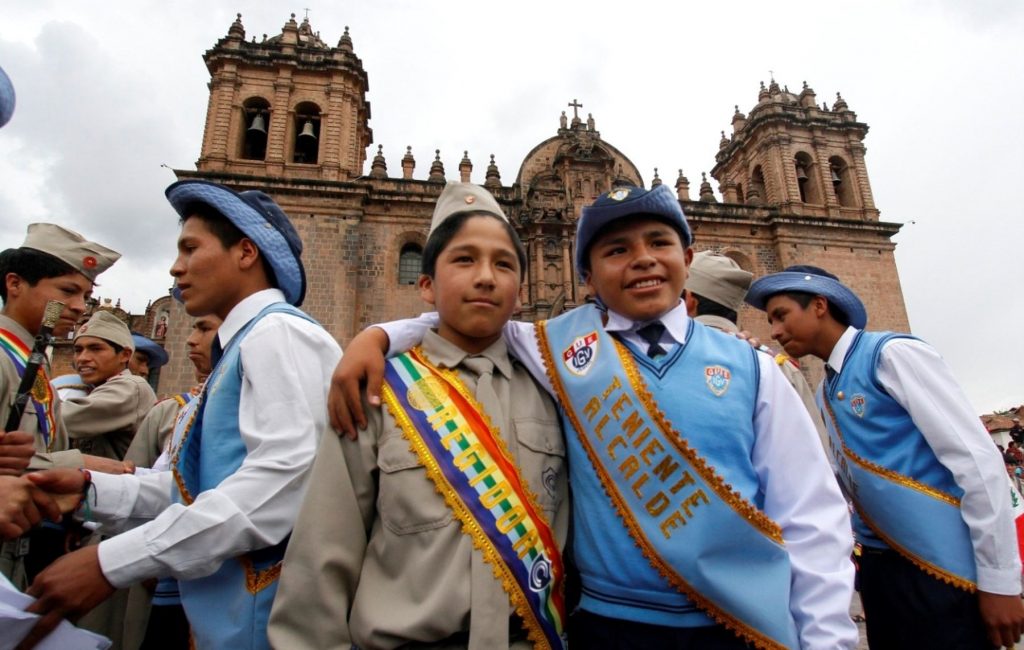How is Formal Spanish so Central in Cusco?

The tall hills and mountains around Cusco look dry and burned by frost, and augury of winter that is coming to the Imperial City. It will not be long before the vendors on its streets and in its markets begin to offer the famous papa helada, the once frozen potatoes, something very typical of the season in Cusco.
They consist of potatoes that are left outside so that they freeze at night only to thaw in the day’s warmth. People consider this potato to be cooked by the freeze and that is one of the classical techniques of cooking in Peru.
I pause on this dish that is so typical of Peru and of the antiquity of its civilization. At the same time that Peru is considered the land of the Incas, the Huancas, and the Moches, among many more, it is also a Hispanic county, tied by language and culture to the Iberian peninsula as well as to other countries where the language of Cervantes demands centrality.

The centrality of this proper and noble Spanish fascinates me this morning when in about a month school children will enter into winter vacations and leave for a time behind these educational centers. I emphasize the central position of this Spanish because there are many Spanishes and, besides, under its banner are found distinct language forms that are tied to the language that is defined by the Royal Spanish Academy y an army of reproducers of this official dialect that holds for itself the word language.
This morning I came to Cusco’s Plaza de Armas thanks to a taxi driver who was proud of being a descendent of the royal panacas of the Incas and, at the same time, spoke to me in an exquisite Andean Spanish. It was not Official Spanish and could even be considered a separate language thanks to its particular grammar that is different from that if the Royal Academy. I was enchanted.

Of course, in Cusco they also speak Quechua in all its variety. Together with the complexity and great variation of local Spanish the city becomes a linguistic labyrinth that yet functions. For now, though, I remain engaged with the question of the importance here of the Spanish that was forged by literary and social elites over centuries.
The other day I was told an experience that took place in a school in a rural town of the Peruvian highlands. An excellent teacher had the students memorize poems from teh classic Spanish and Peruvian corpus, at the same time they would perform portions of Don Quixote and of Blood Wedding,. The experience had a strong impact on the students, as should happen. It also, at the same time, established a relationship of dependency between this corner of the world called Hispanic and the metropolitan world of the Royal Academy, Spain, and their followers.
I say “called Spanish”, not because it is not Hispanic, but to direct attention to the expression “it is said that” in Spanish, or “dicen que”, because of the forms of establishing this world as Hispanic when Peru is itself and very particular, with ten thousand years of history at least, that is that it is not completely Spanish. The term Hispanic or Spanish hide these other language forms as dialects, slangs, regionalism, or barbarisms.
The schools are where many children find this formal Spanish, and become connected with it, though other institutions also play a role, such as the courts, the hospital or clinic, and governmental agencies. At the same time one should recognize the important role played by the Internet, media, in giving legitimacy to one dialect and taking it away from those that are truthfully the majority in Peru.
To this list, I must also add, curiously, publications in Quechua such as the translations of The Quixote and The Little Prince, as well as poetry and even a novel written in quechua. All of these have taken much work and effort and are great achievements and important successes. At the same time, however, hey confirm the centrality of high Spanish in Peruvian life, and the negation of indigenous forms and realities.
The anthropologist Marisol de la Cadena, in her recognized book, Earth Beings: Ecologies of Practice across Andean Worlds, establishes the breaks in translation and practices that the dedication to that Spanish establishes along with those very different ones created by devotion to earth beings, such as some mountains, cliffs, rivers, springs, etc. In this way she explores a different pole of Peruvian reality, one hat is very important and is that of the communities and their practices involving the earth and different beings.
Nevertheless, there are entire societies and a range of linguistic forms and practices in between the two extremes that are often rendered opaque and misunderstood, whether by Hispanocentrism or its academic homologue Andino-centrism, Of course, when i write Hispanocentrism I am not referring to any form of Spanish but to the central one, that which pretends to be and become the the axis of rotation of the wheel of Peruvian life.
“Es que también ps se habla de muchas formas no más. El castellano no es pues uno solo. Había sido como el arcoíris. Tiene muchos colores. Se habla diferente pero.”
This tiny bit of Andean Spanish is from the language I was speaking this morning before sitting down to write. It says “People speak of many forms. Spanish is not singular, rather, surprisingly, it is like a rainbow; it has many colors People just speak differently.” I leave you with that and with the image of the once-frozen potato, la papa helada, which we will be able to eat soon, always with a bit of cheese.




